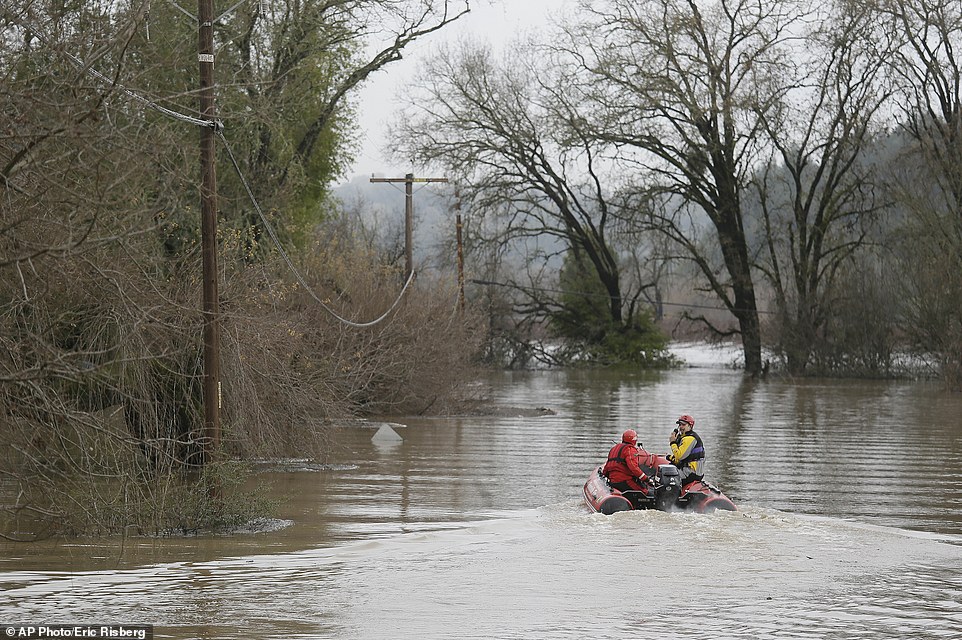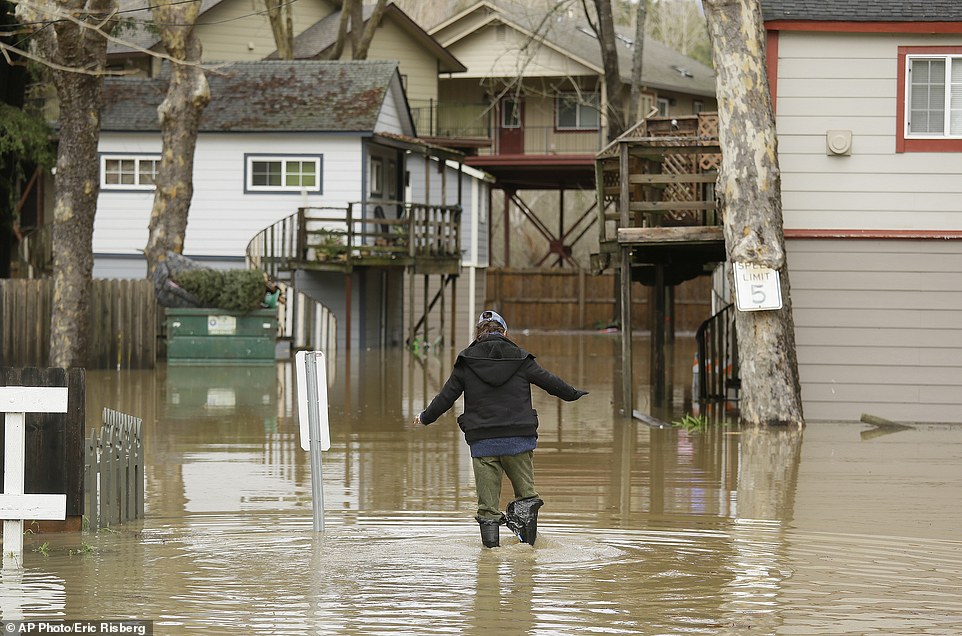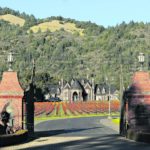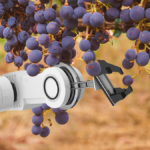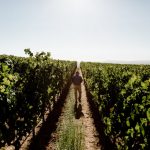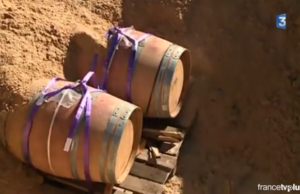Fears for some of California’s top vineyards as record storms drown grape-growing land under feet of water – and more is yet to come
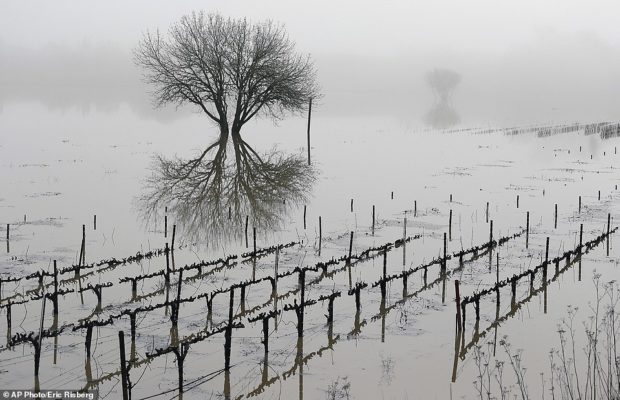
California’s wine industry suffered a blow over the weekend as Sonoma County – home to 60,000 acres of vineyards and more than 425 wineries – was flooded, with up to 13 inches of rain falling since Friday.
The very tips of vines could just about be glimpsed rising from the murky waters drowning the fields along the scenic route known as Rover Road on Monday. The county is two-and-a-half hours due west of Sacramento.
Meanwhile, emergency crews in rescue boats and helicopters rushed to take advantage of a one-day break between storms to rescue stranded people and asses the damage done by the heaviest rains California and Nevada have seen in a decade.
Scroll down for video
Grim forecast: More rain is expected Tuesday due to the ‘atmospheric river’ pressure surge, causing further flooding in the region. Snow is also expected to melt, adding to the burden on the state, and mud and rock slides are predicted
The rains – brought by a storm surge known as an ‘atmospheric river’ – submerged swathes of what is one of California’s top wine production areas, traditionally outproducing the better-known Napa Valley.
Sonoma’s Russian River rose to its highest level since 2006, spilling over its banks and forcing the closure of schools and roads.
And thousands were forced to evacuate and left without power as trees fell and roads disappeared beneath the waters.
The heavy rain even led to the toppling of an iconic sequoia tree that had a drive-thru tunnel carved through its base.
The 33-foot-diameter ‘Pioneer Cabin’ was hollowed out in the 1880s and had been a popular spot for tourists.
But the aged and already dying tree was no match for the powerful currents that, according to park rangers, uprooted it, causing it to shatter on the ground.
And for Californians this is just the beginning.
Another strong storm is bearing down on the region and is expected to hit Tuesday – bringing up to eight more inches of rain to Sonoma County through Tuesday night, and up to 16 inches elsewhere.
Mudslides are also expected, and melting snow likely to add to the devastation.
Mindful of the potentially deadly resurgence, authorities have been working double time to rescue victims and shore up as best they can.
Fire chief Max Ming, of the Russian River town of Forestville, said that the gaps between storms are ‘what saves us from the big water.’
‘People hunker down and wait for it to get past,’ he explained, while his crews launched rafts and used a helicopter to locate stranded citizens.
The Russian River is prone to flooding, but this year’s flood has been particularly worrisome because it threatened to topple many trees weakened by six years of drought.
A flood warning for the river is still in effect, along with a high wind watch planned for Tuesday afternoon and evening, according to Steve Anderson, a National Weather Service forecaster.
The back-to-back storms that have hit California and Nevada since last week are part of an ‘atmospheric river’ weather system that draws precipitation from the Pacific Ocean as far west as Hawaii.
That kind of system, also known as the ‘pineapple express,’ poses catastrophic risks for areas hit by the heaviest rain.
‘It’s been about ten years since we’ve experienced this kind of rainfall,’ said Anderson.
‘We’re getting a little bit of a break today, but we have another storm system arriving tomorrow that’s not quite as potent but could still cause problems.’
Avalanche concerns kept some California ski areas closed for a second day Monday in the Sierra Nevada. Forecasters said more snow and rain was on the way.
Jeff Watts, an artist, spent an anxious night listening for the sound of falling trees on his property in Forestville.
On Monday, he found his drive to work blocked by a car that had slammed into a tree toppled across the road. Emergency crews worked to remove the vehicle.
‘I couldn’t get past the tree, so I turned around and I’m doing this,’ said Watts, who had pulled over to photograph oak trees and their reflections in the floodwater.
Sacramento River levels swelled so much that state officials planned to open a weir located upstream from Sacramento’s Tower Bridge for the first time in more than a decade.
The weir is a barrier of 48 gates that must be opened manually to protect the city of Sacramento from floodwaters.
Yosemite National Park will reopen the valley floor to daytime visitors on Tuesday after it was closed through from Saturday to Monday because of a storm-swollen river, park spokesman Scott Gediman said.
Over the weekend, trees crashed against cars and homes and blocked roads in the San Francisco Bay Area. Stranded motorists had to be rescued from cars stuck on flooded roads. The city itself got just over teo inches of rain.
A giant tree fell across a highway in Hillsborough to the south of San Francisco, injuring a driver who was unable to stop in time and slammed into it.
A woman was also killed Saturday by a falling tree while she took a walk on a golf course.
To the south, near Los Angeles, commuters were warned of possible mudslides in hilly areas.
Things were equally grim in Nevada.
Emergency workers evacuated 400 homes, with around 1,300 people voluntarily being moved from a Reno neighborhood as the Truckee River overflowed and drainage ditches backed up.
Winter storm warnings were in effect in the Sierra Nevada until Thursday, with the potential for blizzard and white-out conditions, said Scott McGuire, a forecaster for the National Weather Service based in Reno.
‘People need to avoid traveling if at all possible,’ McGuire said.
Four-to-eight feet of snow are forecast through Thursday above 7,000 feet, and the Lake Tahoe area could get between two-to-five feet of snow, he said.
Schools were canceled Monday in Reno and Sparks, and Governor Brian Sandoval told all nonessential state government workers to stay home after he declared a state of emergency.
After touring the two cities, Sandoval said no serious injuries were reported during the flooding.
‘It’s bittersweet because it wasn’t as bad as it could have been,’ Sandoval said. ‘But to those people affected, it was really hard on them.’
The state is expected to be hit by further rain on Thursday.

